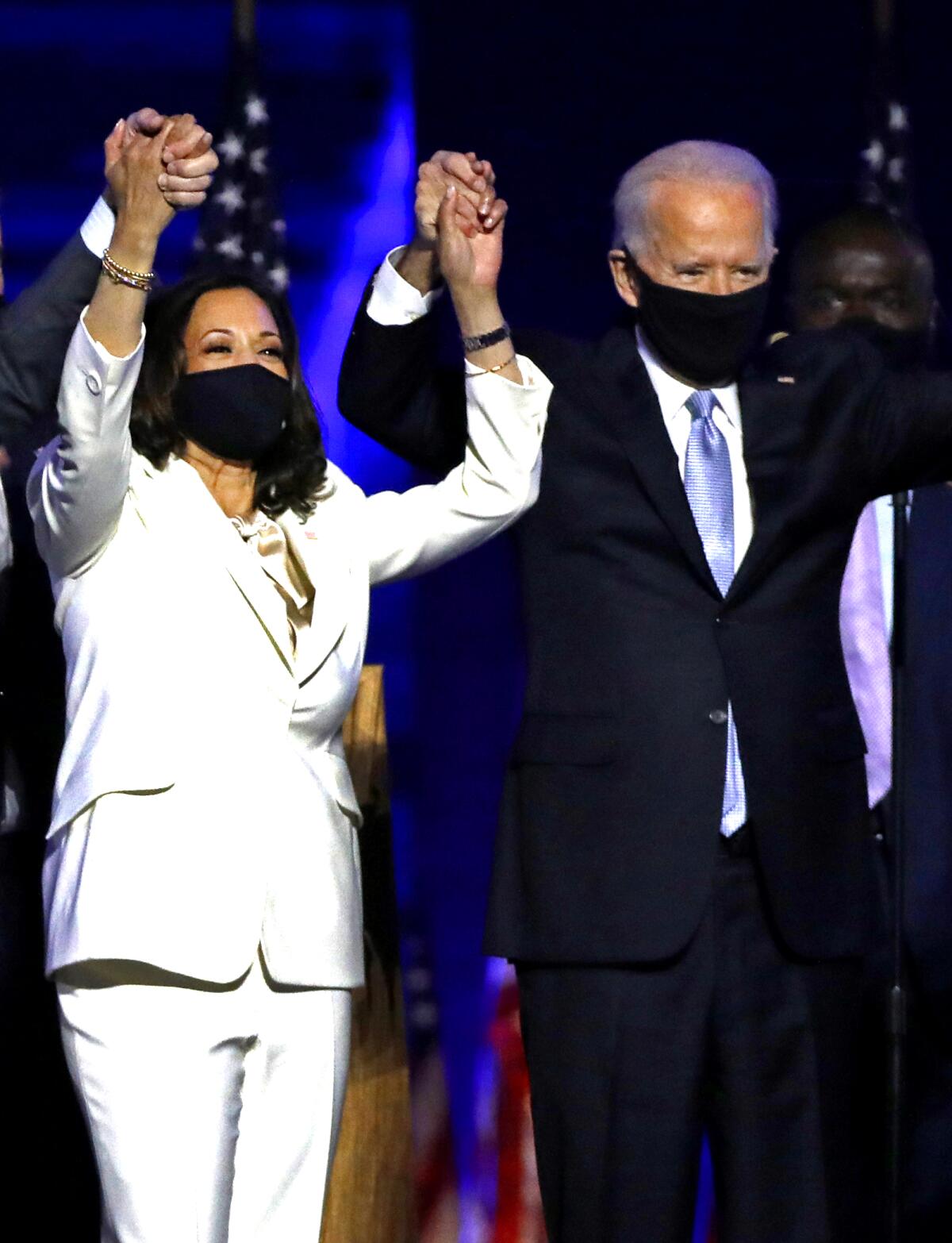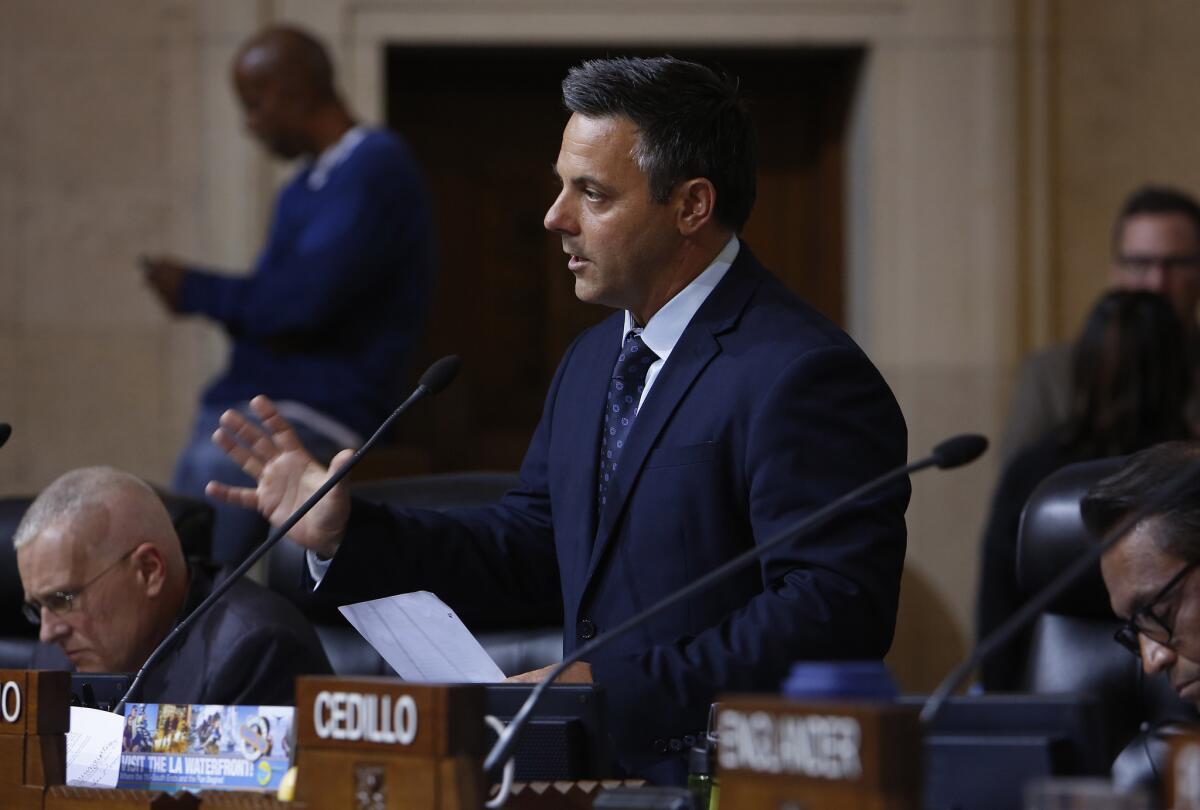California went big for Biden. Now its cities, counties and schools are seeking relief

- Share via
Los Angeles County Supervisor Janice Hahn has high hopes for a Joe Biden presidency, saying it could bring the region more money for public transit and an end to overseas trade wars.
For Oakland Mayor Libby Schaaf, a Biden presidency would put a stop to her city’s battle with President Trump over immigration raids. And for San Jose Mayor Sam Liccardo, the Biden era could mean financial relief for cities desperately trying to balance budgets and avoid slashing services.
“That’s foremost on a lot of mayors’ minds right now — just, can we get a relief package through,” he said. “Because I think many of us expect that the worst of the economic crisis is still ahead of us.”
The ticket of Biden and Kamala Harris swept California this year, to no one’s surprise, securing nearly two-thirds of the vote so far. The margins were even higher in the state’s biggest cities, frequently topping 70%.
Now, officials in the state’s major urban areas, and in multiple sectors of local government, are hoping Biden can engineer a burst of financial support, helping Californians reeling from job losses and struggling to educate their children, while stemming the spread of COVID-19.
Few big cities in California have more on the line than Los Angeles, which is grappling with a major homelessness crisis and a projected deficit of at least $400 million by the end of June — a figure equal to nearly all of the city’s reserves. One dire projection has put the city’s financial gap at $600 million, or nearly a tenth of the general fund, which pays for police, firefighters and other core services.
Without a relief bill, “we’re going to see layoffs,” said Councilman Joe Buscaino, who represents a district stretching from Watts to San Pedro.

Biden vowed during the campaign to provide financial aid to state and local governments, helping them avert layoffs of teachers, firefighters and other public employees. He promised to bring congressional leaders together on financial relief measures, increasing Social Security checks by $200 per month and forgiving at least $10,000 per person in student loan debt.
Those efforts have been complicated by the Democrats’ failure to take control of the Senate, which declined before the election to take up a House bill containing nearly $1 trillion for state and local governments.
Buscaino, who is president of the National League of Cities, which advocates for thousands of cities nationwide, was disappointed to see the relief bill stall. But he remains optimistic that Biden, who began his political career on the New Castle County Council in Delaware, will look out for cities and counties.
“He gets us. He understands us. It’s where he started,” Buscaino said.
It’s still possible that Trump and Congress could reach an agreement on limited COVID-19 relief, said political analyst Jessica Levinson. House Speaker Nancy Pelosi (D-San Francisco) said last week that she was prepared to keep working with the president and the GOP, and Senate Majority Leader Mitch McConnell (R-Ky.) has argued in favor of a “highly targeted” bill.
Phil Washington has overseen a period of ambitious rail expansion in L.A. County.
However, Democrats could end up holding off until next year, in hopes of securing a larger package under a new president, said Levinson, a Loyola Law School professor. And depending on the fate of two U.S. Senate seats in Georgia, there could easily be a divided federal government under Biden, she said.
“Even with Kamala Harris having a big seat at the table, I don’t think California and Los Angeles should expect a windfall,” Levinson said.
Among officials in California, the hopes for a Biden administration are falling into three categories. Some, like those working inside Los Angeles City Hall, are looking to stay financially afloat. Others are thinking of long-range goals, such as new infrastructure projects and measures to combat climate change. Still others are banking on a new era of cooperation and an end to legal and political skirmishes with the Trump administration.
Earlier this year, the California Community College system sued the federal government, saying it was illegally denying coronavirus relief funds to an array of students, including those participating in the Deferred Action for Childhood Arrivals program. Eloy Ortiz Oakley, chancellor of the community college system, said he has “no doubt” that Biden will work more collaboratively.
“I’m just looking forward to a very different tone,” Oakley said. “And not having to worry about what fight I’m going to have to fight with the Department of Education this week.”
Schaaf, the Oakland mayor, said her city has been at odds with Trump for his threat to cut funding for “sanctuary cities.” In 2018, she alerted her constituents that a federal immigration raid was imminent, prompting Trump to call on the Department of Justice for an investigation of her actions.
“It will be a relief simply to have a president who is not at war with America’s diverse, progressive cities and, instead, to actually have allies in the White House,” she said. “I cannot tell you how relieved I am for my city.”
Judd Deere, a Trump spokesman, disputed the notion that the administration had been insufficiently supportive, saying the president had delivered “unprecedented” resources for combating coronavirus to a state that has long been mismanaged.
“The president ushered in a new era of economic dominance before the onset of the pandemic and prioritized keeping our citizens safe,” Deere said in an email. “Instead, California’s leaders have supported destructive liberal policies that killed jobs, increased housing costs, provided sanctuary to criminal illegal aliens and ignored long-time environmental issues.”
Under Trump, California received $15.3 billion in CARES Act funding earlier this year, with $5.8 billion going directly to the state’s most populous counties and cities. The remaining $9.5 billion was divvied up by Gov. Gavin Newsom and state lawmakers, with more than half going to K-12 schools and smaller communities.
Nevertheless, public school officials warn they still need help covering massive costs created by the pandemic, including the purchase of computers and WiFi hot spots, teacher training and other expenses related to online learning.
School districts have also poured money into safety measures aimed at helping students return to campus: COVID-19 testing, air filters and personal protective equipment. And while this year’s state budget granted school districts a short-term financial reprieve, the spending plan was dependent on an expected $14 billion in federal relief funds, education officials said.
“If we don’t see a federal backfill, there is a huge funding cliff that is facing schools in the coming year,” said Xilonin Cruz-Gonzalez, president of the California School Boards Assn. “It’s a scary prospect when you look at the kind of cuts that schools would see if we do not get additional federal funding this year.”
Health experts continue to warn against gatherings with anyone outside your household during the holidays.
Despite major gains in online learning, up to 1 million California students still lack connectivity, state education officials said. Debra Duardo, superintendent of the L.A. County Office of Education, said she would like the Biden administration to find ways to increase high-speed internet access for students, possibly by having the Federal Communications Commission allow discounts for students studying at home.
U.S. Rep. Lou Correa (D-Santa Ana) said Biden’s top priority will have to be COVID-19 and safely reopening the economy.
“My biggest employer in my district is Disneyland, and they are shut down tight,” he said. “And that means the hotels around them are dying. The little stores and hotels are going out of business.”
While public officials universally want action on COVID-19, some are looking beyond the pandemic to an array of initiatives that might not have previously been possible.
Hahn, the county supervisor, has a long wish list for a Biden administration: funding for rail lines that connect the Westside with the San Fernando Valley, money to replace existing bus and truck fleets with electric vehicles, an immigration reform bill that ensures that “residents of L.A. County don’t have to be afraid of being assaulted in the early mornings by [Immigration and Customs Enforcement].”
“He’s going to get back to the things that matter: clean air, clean water, transportation, affordable housing,” said Hahn, whose district stretches from Diamond Bar to Marina del Rey.
L.A. County has received funding from both the state and federal government to respond to the pandemic, including $1.2 billion from the CARES Act, half of which has gone toward public health, emergency food relief and efforts to slow the spread of the virus. With unemployment high, some worry that a growing number of residents will turn to the county’s safety-net services, just as tax revenue has softened.
Supervisor Hilda Solis said she’s optimistic that Biden and his allies will provide relief to local agencies, including the county, which has a $35-billion budget and a population of 10 million.
“They know when L.A. County coughs, there’s going to be tremors,” Solis said.
Times staff writers Nina Agrawal, Jaclyn Cosgrove, Paloma Esquivel, Jennifer Haberkorn and John Myers contributed to this report.
More to Read
Sign up for Essential California
The most important California stories and recommendations in your inbox every morning.
You may occasionally receive promotional content from the Los Angeles Times.














